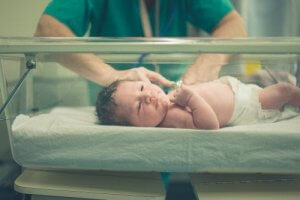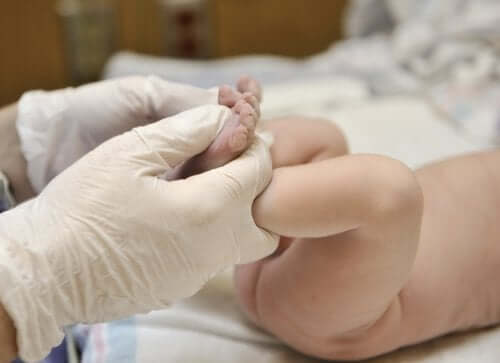Neonatology: Definition and Characteristics


Written and verified by the nurse Miriam Barriga Sánchez
Neonatology is the branch of pediatrics responsible for the study and care of newborns up to 28 days of life.
Neonatology has advanced greatly in recent years and the care models in neonatal units have evolved. This has allowed the support of parents and family and their integration into the care of their newborn.
The evolution of neonatology
In developed countries, infant and maternal mortality follow a downward pattern. However, neonatal mortality and morbidity are still worrisome. This is mainly due to the long-term consequences in children, their families, and health and social services.
Some of the main factors involved in perinatal mortality and morbidity are:
- Extremely premature infants.
- Low birth weight (less than 5.5 pounds).
- Birth defects.

In this regard, the incidence of these complications has increased in many countries, which reflects the fact that these situations need to be prevented. However, medical advances that reduce mortality and morbidity in these children are notorious.
These are some of the population risk factors:
- Maternal age. The older the mother is, the higher the risk.
- Smoking during pregnancy.
- High maternal weight before and during pregnancy.
- The use of assisted reproductive technology (ART). The use of ART increases the risk of multiple pregnancies, which involves an increased risk of preterm labor, suffering birth defects, and growth retardation.
- Newborn feeding (infant formula versus breastfeeding).
All these changes have led to the evolution of neonatology as a science. The neonatal survival rates of this day and age were unthinkable years ago.
How neonatal units work
Neonatal units should promote breastfeeding and care focused on development. In addition, the facilities must meet the physiological and psychosocial needs of infants, parents, and family members.
Also, parents or responsible family members should have access to their newborns 24 hours a day, 7 days a week. In addition, they must be encouraged to participate in their care, encouraging skin-to-skin contact.
In this sense, all neonatal units must ensure the following screenings:
- Metabolic screening.
- Hearing screening.
They must also have protocols for performing techniques and procedures, as well as how to develop a clinical history for each newborn.
Neonatal levels of care
There are different neonatal unit levels depending on the number of births in the hospital, the referral area, and benefits offered.
Level I (well newborn nursery)
Firstly, all hospitals with maternity units should at least have a neonatal unit of these characteristics. The general functions of this unit are:
- Resuscitation in delivery and operating rooms.
- Neonatal stabilization due to unexpected problems.
- Assistance to low-risk pregnancies, healthy term infants, and physiologically stable infants born at 35-37 weeks.
- Assistance, exploration, and identification of neonatal diseases in healthy newborns.
- Tracking system in primary care for discharged newborns.

All neonatal units:
- Support breastfeeding.
- Control of the thermal environment.
- Cardiorespiratory monitoring and neonatal pulse oximetry.
- Gastric tube feeding availability.
- Devices to determine blood glucose levels.
- Devices to determine blood pressure.
- Nasal cannulas.
- Devices for administering fluids, glucose, or medication intravenously.
- Unit open to parents 24 hours a day, 7 days a week.
Level II (special care nursery)
Secondly, these units are located in general hospitals. Thus, all hospitals with at least 1000 births a year must have a level II unit. In addition to the functions level I units offer, this unit provides:
- Assistance to selected complicated gestations and infants born ≥32-week gestation and weighing ≥1500 g.
- Care of newborns with mild diseases.
- Assistance to infants from the referral center who have improved.
- Monitoring programs for the development of high-risk infants.
- Care of infants with moderate diseases that may require mechanical ventilation or non-invasive ventilation.
Level II units provide all those described in level I units, plus the following:
- Space destined for the care of sick newborns.
- Continuous cardiorespiratory monitoring.
- Peripheral intravenous (IV) cannulation (fluids, antibiotics, glucose…).
- Short-term mechanical ventilation or non-invasive ventilation.
- Diagnostic radiology and basic ultrasound.
- Peripheral or central administration of total parenteral nutrition or medication.
- Insertion of umbilical or peripheral arterial catheter for monitoring.
Level III (neonatal intensive-care unit)
Finally, these units are found in referral hospitals with a pediatric ward where all or most of their specific areas are developed.
You can find these units in hospitals with more than 2,000 deliveries a year. These are the functions of these units, in addition to the ones we described above:
- Firstly, assistance to seriously ill infants, including those who require conventional mechanical ventilation.
- Also, minor surgical procedures.
- Assistance of all complicated pregnancies and newborn infants of any gestational age and weight.
- Likewise, advanced respiratory support.
- Pediatric surgery for major surgical interventions.
- Finally, care for newborns who require a full range of medical and surgical pediatric care.

In addition to all the capabilities we explained above, level III units are able to:
- Firstly, prolonged conventional mechanical ventilation, minor surgical procedures, and prolonged central venous catheterization.
- Surgery to treat surgical complications.
- Also, advanced respiratory support.
- Advanced imaging techniques with quick interpretation by specialized radiologists.
- Likewise, cardiac surgery with cardiopulmonary bypass.
- Neonatal ECMO.
- Finally, pediatric organ transplant.
In conclusion
In short, we’d like to emphasize that the neonatologists and pediatricians that work in neonatal units are skilled health professionals. Thus, if your child requires neonatology, trust them and follow their advice. Your child will be in good hands!
Neonatology is the branch of pediatrics responsible for the study and care of newborns up to 28 days of life.
Neonatology has advanced greatly in recent years and the care models in neonatal units have evolved. This has allowed the support of parents and family and their integration into the care of their newborn.
The evolution of neonatology
In developed countries, infant and maternal mortality follow a downward pattern. However, neonatal mortality and morbidity are still worrisome. This is mainly due to the long-term consequences in children, their families, and health and social services.
Some of the main factors involved in perinatal mortality and morbidity are:
- Extremely premature infants.
- Low birth weight (less than 5.5 pounds).
- Birth defects.

In this regard, the incidence of these complications has increased in many countries, which reflects the fact that these situations need to be prevented. However, medical advances that reduce mortality and morbidity in these children are notorious.
These are some of the population risk factors:
- Maternal age. The older the mother is, the higher the risk.
- Smoking during pregnancy.
- High maternal weight before and during pregnancy.
- The use of assisted reproductive technology (ART). The use of ART increases the risk of multiple pregnancies, which involves an increased risk of preterm labor, suffering birth defects, and growth retardation.
- Newborn feeding (infant formula versus breastfeeding).
All these changes have led to the evolution of neonatology as a science. The neonatal survival rates of this day and age were unthinkable years ago.
How neonatal units work
Neonatal units should promote breastfeeding and care focused on development. In addition, the facilities must meet the physiological and psychosocial needs of infants, parents, and family members.
Also, parents or responsible family members should have access to their newborns 24 hours a day, 7 days a week. In addition, they must be encouraged to participate in their care, encouraging skin-to-skin contact.
In this sense, all neonatal units must ensure the following screenings:
- Metabolic screening.
- Hearing screening.
They must also have protocols for performing techniques and procedures, as well as how to develop a clinical history for each newborn.
Neonatal levels of care
There are different neonatal unit levels depending on the number of births in the hospital, the referral area, and benefits offered.
Level I (well newborn nursery)
Firstly, all hospitals with maternity units should at least have a neonatal unit of these characteristics. The general functions of this unit are:
- Resuscitation in delivery and operating rooms.
- Neonatal stabilization due to unexpected problems.
- Assistance to low-risk pregnancies, healthy term infants, and physiologically stable infants born at 35-37 weeks.
- Assistance, exploration, and identification of neonatal diseases in healthy newborns.
- Tracking system in primary care for discharged newborns.

All neonatal units:
- Support breastfeeding.
- Control of the thermal environment.
- Cardiorespiratory monitoring and neonatal pulse oximetry.
- Gastric tube feeding availability.
- Devices to determine blood glucose levels.
- Devices to determine blood pressure.
- Nasal cannulas.
- Devices for administering fluids, glucose, or medication intravenously.
- Unit open to parents 24 hours a day, 7 days a week.
Level II (special care nursery)
Secondly, these units are located in general hospitals. Thus, all hospitals with at least 1000 births a year must have a level II unit. In addition to the functions level I units offer, this unit provides:
- Assistance to selected complicated gestations and infants born ≥32-week gestation and weighing ≥1500 g.
- Care of newborns with mild diseases.
- Assistance to infants from the referral center who have improved.
- Monitoring programs for the development of high-risk infants.
- Care of infants with moderate diseases that may require mechanical ventilation or non-invasive ventilation.
Level II units provide all those described in level I units, plus the following:
- Space destined for the care of sick newborns.
- Continuous cardiorespiratory monitoring.
- Peripheral intravenous (IV) cannulation (fluids, antibiotics, glucose…).
- Short-term mechanical ventilation or non-invasive ventilation.
- Diagnostic radiology and basic ultrasound.
- Peripheral or central administration of total parenteral nutrition or medication.
- Insertion of umbilical or peripheral arterial catheter for monitoring.
Level III (neonatal intensive-care unit)
Finally, these units are found in referral hospitals with a pediatric ward where all or most of their specific areas are developed.
You can find these units in hospitals with more than 2,000 deliveries a year. These are the functions of these units, in addition to the ones we described above:
- Firstly, assistance to seriously ill infants, including those who require conventional mechanical ventilation.
- Also, minor surgical procedures.
- Assistance of all complicated pregnancies and newborn infants of any gestational age and weight.
- Likewise, advanced respiratory support.
- Pediatric surgery for major surgical interventions.
- Finally, care for newborns who require a full range of medical and surgical pediatric care.

In addition to all the capabilities we explained above, level III units are able to:
- Firstly, prolonged conventional mechanical ventilation, minor surgical procedures, and prolonged central venous catheterization.
- Surgery to treat surgical complications.
- Also, advanced respiratory support.
- Advanced imaging techniques with quick interpretation by specialized radiologists.
- Likewise, cardiac surgery with cardiopulmonary bypass.
- Neonatal ECMO.
- Finally, pediatric organ transplant.
In conclusion
In short, we’d like to emphasize that the neonatologists and pediatricians that work in neonatal units are skilled health professionals. Thus, if your child requires neonatology, trust them and follow their advice. Your child will be in good hands!
All cited sources were thoroughly reviewed by our team to ensure their quality, reliability, currency, and validity. The bibliography of this article was considered reliable and of academic or scientific accuracy.
- S. Rite Gracia, J.R. Fernández Lorenzo, I. Echániz Urcelay, F. Botet Mussons, G. Herranz Carrillo, J. Moreno Hernando, E. Salguero García, M. Sánchez Luna. (2013). Niveles asistenciales y recomendaciones de mínimos para la atención neonatal. An Pediatr (Barc). 2013; 79(1):51.e1—51.e11. Disponible en: https://www.analesdepediatria.org/es-pdf-S1695403312004869
- Cuidados desde el nacimiento. (2010). Recomendaciones basadas en pruebas y buenas prácticas. Ministerio de Sanidad y Política Social. Sanidad. Disponible en: https://www.mscbs.gob.es/organizacion/sns/planCalidadSNS/pdf/equidad/cuidadosDesdeNacimiento.pdf
- Unidades de Neonatología. Estándares y recomendaciones de calidad. (2014). Ministerio de Sanidad, Servicios Sociales e Igualdad. Informes, estudios e investigación. Disponible en: https://www.mscbs.gob.es/organizacion/sns/planCalidadSNS/docs/NEONATOLOGIA_Accesible.pdf.
- MACIAS VILLA, Héctor Luis Guillermo et al. Edad materna avanzada como factor de riesgo perinatal y del recién nacido. Acta méd. Grupo Ángeles [online]. 2018, vol.16, n.2 [citado 2022-09-02], pp.125-132. Disponible en: <http://www.scielo.org.mx/scielo.php?script=sci_arttext&pid=S1870-72032018000200125&lng=es&nrm=iso>. ISSN 1870-7203.
- CHINCHILLA ARAYA, Tamara and DURAN MONGE, María del Pilar. Efectos fetales y posnatales del tabaquismo durante el embarazo. Med. leg. Costa Rica [online]. 2019, vol.36, n.2 [cited 2022-09-02], pp.68-75. Available from: <http://www.scielo.sa.cr/scielo.php?script=sci_arttext&pid=S1409-00152019000200068&lng=en&nrm=iso>. ISSN 2215-5287.
This text is provided for informational purposes only and does not replace consultation with a professional. If in doubt, consult your specialist.








